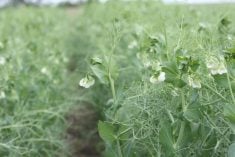UPDATED: September 4, 2024 – 0830 CST – REGINA — The United States has deregulated the HB4 trait in wheat, paving the way for genetically modified wheat to be grown in that country.
However, it will likely be years before GM wheat is commercially available there.
The drought-tolerant and herbicide-resistant trait is available from Bioceres Crop Solutions of Argentina and is approved for use in several countries. The trait comes from sunflowers.
Read Also

Fertilizer method’s link to emissions studied
A researcher says others studying greenhouse gas emissions aren’t considering how the loss of nitrogen into the atmosphere correlates with fertilizer application or if there is an impact to yield.
The company will have to conduct closed-system field trials before it can offer the wheat commercially.
Both the National Association of Wheat Growers and U.S. Wheat Associates (USW) lauded the decision, saying it could help growers increasingly affected by drought conditions.
The U.S. Department of Agriculture’s Animal and Plant Health Inspection Service assessed the variety and concluded it does not pose a plant pest risk greater than conventional wheat.
“APHIS determined that, from a plant pest risk standpoint, HB4 wheat can be safely cultivated and bred in the United States,” said Krista Zuzak, director of crop protection and production at Cereals Canada.
However, she noted this approval is not related to commercial launch of a product.
“To reach the stage of this wheat being grown in the U.S., there would need to be additional work done to introgress HB4 into U.S. optimized wheat varieties, development of seedstock, as well as approvals and launch plans,” she said.
The Canadian Food Inspection Agency said it hasn’t received any requests yet for HB4 wheat as food, feed or for cultivation. The agency said it is monitoring the U.S. developments and preparing for the possibility the variety could be available in the future.
Any GM crop has to go through several steps in the Canadian approval process. This includes a voluntary Notice of Submission to the public. CFIA does not release information about ongoing assessments until a decision is made.
“Both the CFIA and Health Canada conduct comprehensive pre-market assessments to reach a decision on whether the product is safe and suitable for use as food, as livestock feed and as seed,” the agency said.
“Once a decision is made, it is posted online. To prevent market disruptions, the CFIA advises developers to seek regulatory approvals in Canada concurrently with applications in other jurisdictions.”
CFIA also said certain crops, including wheat, require the developer to demonstrate quality of the finished line and receive variety registration before seed can be sold.
Zuzak said Canada’s main concern is market access.
It supports the adoption of safe and proven technologies, she said, but those have to be introduced and adopted in concert with market demand.
“Market access is a critical factor for any of those new technologies and especially in Canada, we do have such a high export volume for wheat production that it’s something we’re carefully watching,” she said.
The debate over GM wheat has been contentious over the years as consumers expressed health concerns about eating products made with such varieties. Monsanto, now Bayer, abandoned its plans to commercialize GM wheat 20 years ago after importers threatened not to purchase it.
Zuzak said technology is advancing so rapidly, however, that traits such as drought tolerance may someday be introduced through gene editing, which is more widely accepted.
“There are different market access considerations for gene edited crops compared to genetically modified crops,” she said.
NAWG thanked the USDA for the decision “to provide a robust, science-based process that affords a pathway for the cultivation of the HB4 trait in the United States.”
The organization said drought-tolerant wheat could help meet global supply challenges and sustainability goals.
“Over the past few years, wheat producers across the major wheat producing regions have had to grapple with intense drought, and continued innovations like HB4 can be a tool that helps growers protect and stabilize their yields,” said president Keeff Felty.
NAWG board member Kyler Millershaski said he went to Argentina to see the crop in the field and meet with Bioceres. He said the wheat offers tremendous potential.
USW said it will monitor Bioceres’ commercialization plan to be sure it aligns with the Wheat Industry Principles for Biotechnology Commercialization that it developed with NAWG.
The two organizations said their support for HB4, and any other transgenic wheat commercialization, is linked to the technology company receiving regulatory approval in importing countries representing at least five per cent of average U.S. wheat export volume.
Bioceres said the U.S., the world’s fourth-largest wheat producer, is the fourth country to allow HB4 production, after Argentina, Brazil and Paraguay.
“Australia, New Zealand, South Africa, Nigeria, Thailand, Indonesia, Colombia and Chile have all approved the technology for food and feed use,” the company said.
Australia recently allowed the company to begin field trials.
Contact karen.briere@producer.com


















